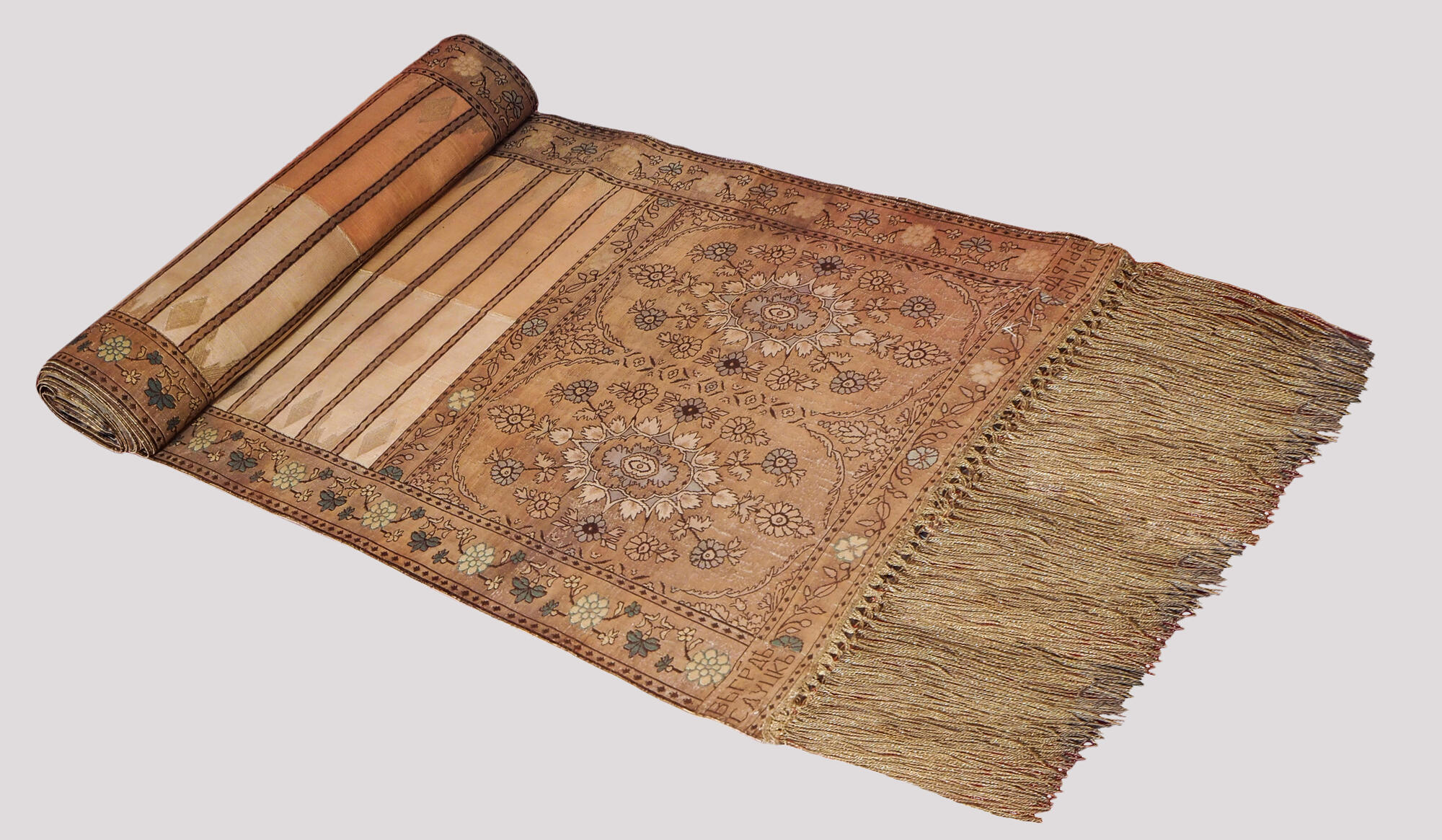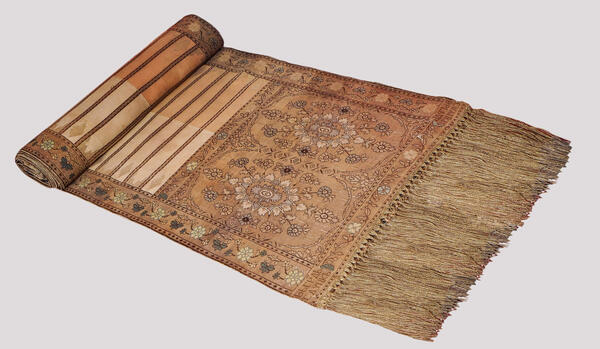The Slutsk belt was an indispensable status attribute of the male gentry costume of the Grand Duchy of Lithuania. It is a long belt of luxurious fabric, 30-50 cm wide, woven of silk, gold and silver threads. Such belts ended with a silk gold-woven fringe, 12 to 30 cm wide. The belt was folded in half or twisted and tied over the kuntush — men’s coat. A weapon was attached to the belt. The Slutsk belt testified to the noble origin and well-being of its owner.
The name of the belt comes from the city of Slutsk in Belarus, where the most famous manufacturer of belts was located. Its creator was the tycoon Mikhail Kazimir Radziwill, the great hetman of Lithuania. In 1757, the Turkish textile master Hovhannes Madjarants was invited to Slutsk. In the Polish-Lithuanian Commonwealth, the name of Hovhannes Madzhants was changed in the local manner — Jan Madzharsky. The son of Jan Madzharsky, Leon, headed the Slutsk manufactory in 1777-1807. During this period, an additional inscription appears at the belts’ ends: ‘Leon Madjarsky’.
During the heyday of the manufactory, up to 55 weavers and the same number of apprentices worked in Slutsk. Slutsk belts were woven only by men, and only men helped their owners to tie them. It was believed that if a woman’s hand touches precious threads, the fabric will fade, and the belt will become unusable. In the last quarter of the 18th century, the Slutsk Manufactory produced about 200 belts annually. They were very expensive, up to 1000 zlotys. The cost of one such belt was equal to the cost of two good horses. A real Slutsk belt could contain up to 200 grams of gold.
The length of the belt from the collection of the Smolensk Museum is 382 cm, width — 36 cm. It is woven of silk threads and decorated with fringes. Two marks are woven at the ends of the belt. On the light side of the belt — “IN THE CITY OF SLUTSK “, and on the dark side -” LEO MAZHARSKY’. The belt is four-sided. On the one side, it is gold and pink, and on the other — blue and brown. The four-sided Slutsk belts were considered the most valuable. Each side of the belt was divided into two pieces of different colors, and the belt was folded in half. One of the sides was used depending on the color of the outfit and the situation. For example, on a holiday, a belt was tied outside with a gold, red part; black or dark side was used in mourning; in everyday life — green and gray.
Along the edges, the belt is decorated with a narrow-patterned border with blue flowers. At the ends it has two medallions with floral designs. In the center there is an ornament of transverse stripes.
Nowadays authentic belts of the 18th century made in Slutsk are a great rarity. Presumably, only about a thousand of these Slutsk belts have preserved in the world.
The name of the belt comes from the city of Slutsk in Belarus, where the most famous manufacturer of belts was located. Its creator was the tycoon Mikhail Kazimir Radziwill, the great hetman of Lithuania. In 1757, the Turkish textile master Hovhannes Madjarants was invited to Slutsk. In the Polish-Lithuanian Commonwealth, the name of Hovhannes Madzhants was changed in the local manner — Jan Madzharsky. The son of Jan Madzharsky, Leon, headed the Slutsk manufactory in 1777-1807. During this period, an additional inscription appears at the belts’ ends: ‘Leon Madjarsky’.
During the heyday of the manufactory, up to 55 weavers and the same number of apprentices worked in Slutsk. Slutsk belts were woven only by men, and only men helped their owners to tie them. It was believed that if a woman’s hand touches precious threads, the fabric will fade, and the belt will become unusable. In the last quarter of the 18th century, the Slutsk Manufactory produced about 200 belts annually. They were very expensive, up to 1000 zlotys. The cost of one such belt was equal to the cost of two good horses. A real Slutsk belt could contain up to 200 grams of gold.
The length of the belt from the collection of the Smolensk Museum is 382 cm, width — 36 cm. It is woven of silk threads and decorated with fringes. Two marks are woven at the ends of the belt. On the light side of the belt — “IN THE CITY OF SLUTSK “, and on the dark side -” LEO MAZHARSKY’. The belt is four-sided. On the one side, it is gold and pink, and on the other — blue and brown. The four-sided Slutsk belts were considered the most valuable. Each side of the belt was divided into two pieces of different colors, and the belt was folded in half. One of the sides was used depending on the color of the outfit and the situation. For example, on a holiday, a belt was tied outside with a gold, red part; black or dark side was used in mourning; in everyday life — green and gray.
Along the edges, the belt is decorated with a narrow-patterned border with blue flowers. At the ends it has two medallions with floral designs. In the center there is an ornament of transverse stripes.
Nowadays authentic belts of the 18th century made in Slutsk are a great rarity. Presumably, only about a thousand of these Slutsk belts have preserved in the world.



